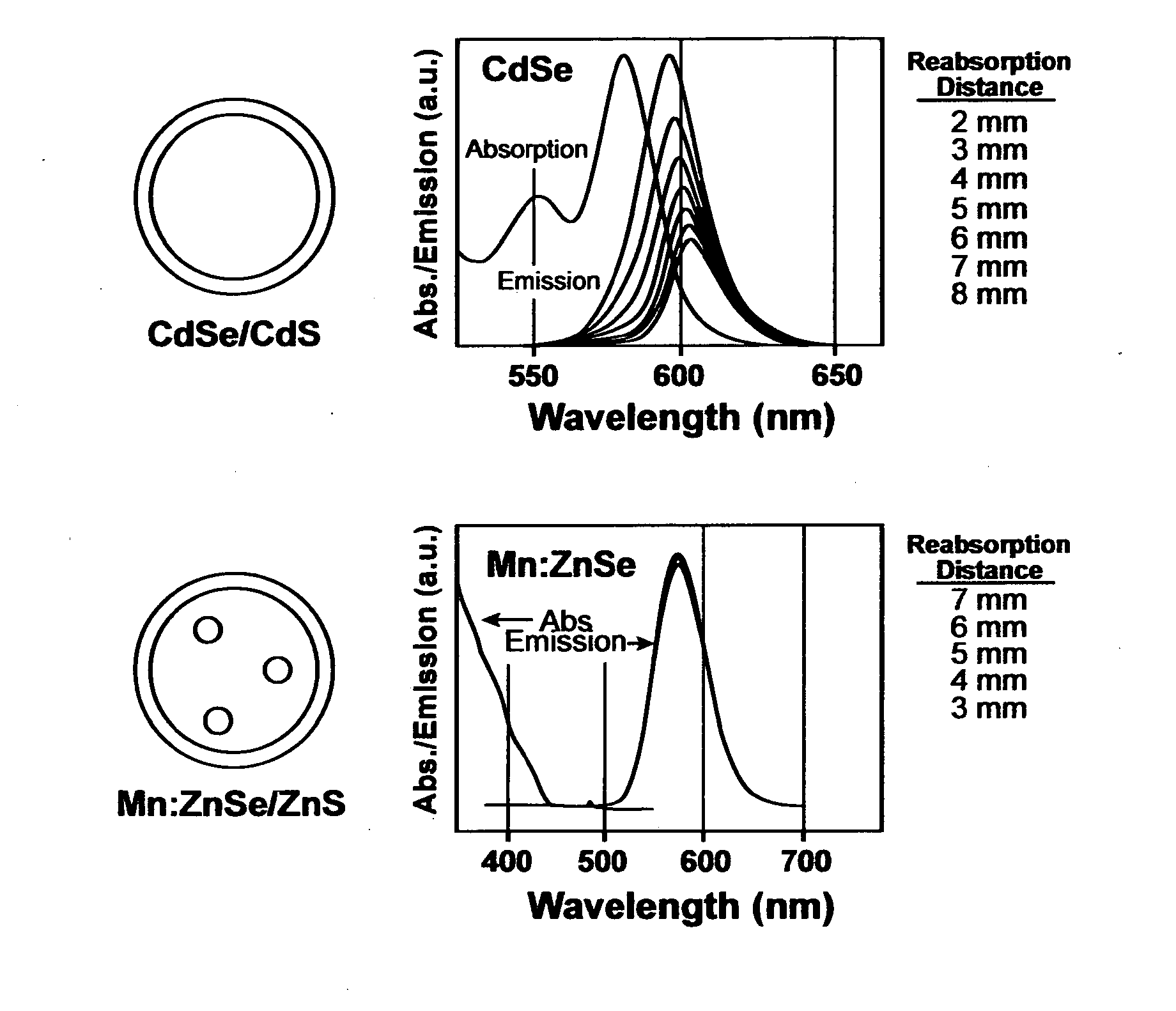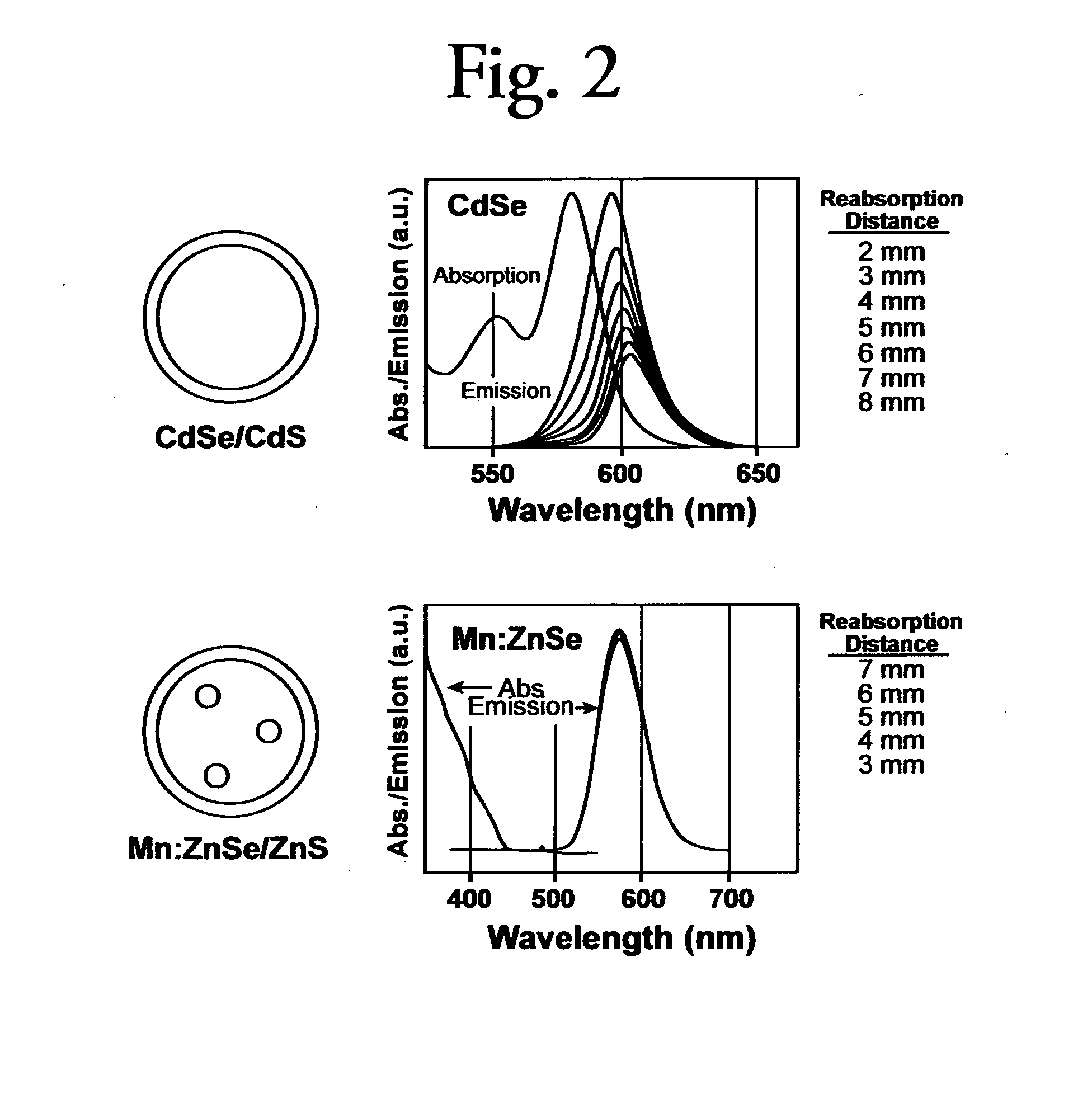Semiconductor nanocrystals used with LED sources
- Summary
- Abstract
- Description
- Claims
- Application Information
AI Technical Summary
Benefits of technology
Problems solved by technology
Method used
Image
Examples
example 1
Synthesis of Cu Doped ZnSe Quantum Dots
Chemicals Used:
[0093]Zinc acetate, 1-Octadecene (ODE), Oleylamine (70%), Decanoic Acid (99+%), Tributylphosphine (TBP) were purchased from Aldrich, and Copper Chloride 99.999% (anhydrous), Manganese Chloride (99+%), Zinc Chloride (99+%), and Oleic Acid from Alpha Aesar. Se and S powder were also purchased from Aldrich. Manganese Stearate was purchased from City Chemical.
Preparation of Zinc Oleate:
[0094]Zinc Chloride (ZnCl2), anhydrous—-6.841 g
[0095]Oleic Acid—28.241 g
[0096]Tetramethyammonium Hydroxide (TMAH)—18.123 g
Molar Ratios: 2:2:1 Oleic Acid:TMAH:ZnCl2, respectively.
Synthesis Procedure Used
[0097]1. Dissolve the ZnCl2 in 200 mL of methanol in a 250 mL separatory funnel.
[0098]2. Dissolve the Oleic Acid and TMAH in 500 mL methanol in a 1 L 3-neck round bottom flask. Stir 30 minutes at room temperature.
[0099]3. Add the ZnCl2 drop wise to the stirring solution of Oleic Acid and TMAH over a period of 1-2 hours.
[0100]4. Allow the reaction to stir...
example 2
Synthesis of Mn Doped ZnSe Quantum Dots
Synthesis Procedure of Mn Doped ZnSe Quantum Dots:
[0140]1. Place a stir bar into a clean, dry 250 mL three-neck round bottom flask.
[0141]2. To the 250 mL 3-neck round bottom flask, add 0.2 g Manganese Stearate and 50 g ODE.
[0142]3. Place the flask in a fitted heating mantle. Attach a condenser, thermocouple sleeve, and septum. Turn on an Argon flow through the flask.
[0143]4. Bubble Argon through the solution while stirring.
[0144]5. Heat the reaction solution up to 120° C. while bubbling Argon for at least 15 minutes.
[0145]6. The Zinc injection solution, growth solution, and amine solution are best effective when heated to 100° C. and purged with Argon before use. For the Zinc injection solution it will need to be heated to at least 100° C. before injection.
[0146]7. Heat the reaction solution up to 270° C., the reaction may be a slight brownish color but will be completely clear at 270° C. If the reaction does not become clear or is very dark / co...
example 3
Dispersion of Doped Quantum Dots in Polymer (Silicone)
[0161]A specific amount of solution (either Hexanes or Chloroform) containing a concentrated amounts of purified d-dots is added to an amount of Dow Corning 2-8630 silicone polymer fluid. Typically, 100 mg of d-dots are added to 5 grams of 2-8630 silicone fluid. The amounts will depend upon use, but maximum concentrations are 250 mg of d-dots in 1 gram of 2-8630 silicone fluid. The fluid mixture is then shaken / stirred vigorously until the nanomaterials are fully dissolved. The fluid is then put under vacuum for 12-24 hours to remove all excess solvent. The silicone fluid is then removed from the vacuum chamber and 250 μL of chloroform containing 150 μg of trimethylolpropane triacrylate (TMPTA) is added. 50 μL of chloroform and 30 μg of TMPTA are needed to cure 1 gram of 2-8630 silicone fluid. Chloroform is necessary to uniformly distribute the TMPTA curing agent throughout the 2-8630 silicone fluid. The mixture is then shaken / sti...
PUM
 Login to View More
Login to View More Abstract
Description
Claims
Application Information
 Login to View More
Login to View More - R&D
- Intellectual Property
- Life Sciences
- Materials
- Tech Scout
- Unparalleled Data Quality
- Higher Quality Content
- 60% Fewer Hallucinations
Browse by: Latest US Patents, China's latest patents, Technical Efficacy Thesaurus, Application Domain, Technology Topic, Popular Technical Reports.
© 2025 PatSnap. All rights reserved.Legal|Privacy policy|Modern Slavery Act Transparency Statement|Sitemap|About US| Contact US: help@patsnap.com



